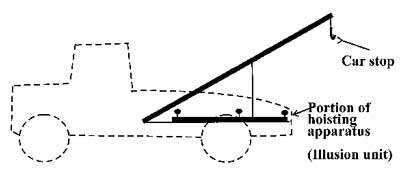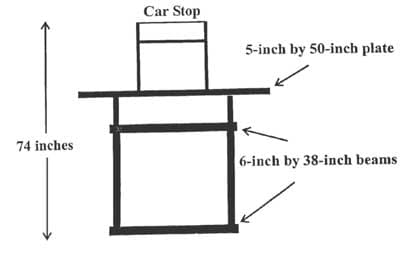Fourteen-Year-Old Laborer Dies After a Stored Piece of Hoisting Apparatus Fell on Him at an Automobile Repossession Yard - Pennsylvania
NIOSH In-house FACE Report 2000-04
Summary
A 14-year-old male laborer (the victim) died of crushing injuries after a damaged portion of hoisting apparatus (illusion unit) at an automobile repossession yard fell on him. The youth had been hired to pull weeds and perform general clean-up around the perimeter of the yard and the buildings located within the yard. At the time of the incident, the youth was pulling weeds in the vicinity of a 74½-inch-high, 300-pound portion of hoisting apparatus that was positioned but unsecured against one of the buildings in the yard. The incident was unwitnessed, but the presence of several large weeds behind the unit indicates that the victim might have been trying to move the illusion unit to gain access to the weeds when the unit fell on him. The victim was last seen at lunch. When his father, who also worked at the repossession yard, went to look for him an hour later he found the victim underneath the fallen unit. The father lifted the unit off of the victim and called the Emergency Medical Service (EMS) from the company office. Due to the extent of the victim’s injuries, no first aid was attempted. When the EMS arrived they summoned the coroner, who pronounced the victim dead at the scene.
NIOSH investigators concluded that, to help prevent similar incidents, employers should:
- isolate, stabilize, dismantle or restrain equipment that has been out of service in such a manner that would prevent employee exposure
- comply with child labor laws which prohibit youth 14 and 15 years of age from working in occupations that involve warehousing and storage
- ensure that constant supervision is provided when youths are present in a working environment
- develop, implement, and enforce a comprehensive safety program.
Introduction
On August 8, 1999, a 14-year-old male laborer (the victim) died of crushing injuries after a portion of hoisting apparatus (illusion unit) used in the repossession of vehicles fell on him in an automobile repossession yard. On October 25, 1999, the National Institute for Occupational Safety and Health (NIOSH), Division of Safety Research (DSR), was notified of the incident by the U.S. Department of Labor, Wage and Hour Division. On February 2, 2000, a DSR occupational safety and health specialist conducted an investigation of the incident. The incident was reviewed with the Wage and Hour Assistant District Director and the Federal OSHA compliance officer assigned to the case. The death certificate and photographs taken immediately after the incident were reviewed. The employer declined to participate in the investigation.
The employer operated an automobile repossession business. He had operated the business for over 20 years and employed 11 people. Repossessed automobiles were hauled to the company’s yard and stored there until they were hauled by a vehicle transporter to another predetermined location. The employer had no written safety policy or safety program. Any training to those involved in the repossession or transport of vehicles was provided on the job. The victim had received no training for the duties he was performing. This was the second summer the victim had done odd jobs at the yard on a part-time basis. This was the employer’s first fatality.
Back to Top
Investigation
The victim had performed odd jobs at the automobile repossession yard the past two summers. The victim and his father, who also worked there, had negotiated a price of between fifty and one hundred dollars to pull weeds and do general clean-up around the 186-foot by 78½-foot yard at the facility. The final amount paid would be determined by the amount of time taken to perform the work.
On August 8th, the victim began work at 9:00 a.m. He pulled weeds and cleaned up around the buildings in the yard and along the 8-foot-high chain link fence that surrounded the yard. At 12:00 noon he returned to the company office to eat lunch. At 12:30 p.m. the victim returned to pulling weeds around one of the buildings in the yard, while his father went to load a repossessed vehicle onto a vehicle transporter. At some point between 12:30 p.m. and 1:30 p.m., the victim encountered an illusion unit positioned upright and leaning against a support column for the building.
An illusion unit is a type of hoisting device fabricated out of steel beams, and is used in the repossession of vehicles. The illusion unit is bolted to the floor of the bed of a pickup truck and rests against the floor of the pickup bed until a vehicle to be repossessed is sighted. The driver can then position his truck, raise the illusion unit and lock it into position in the bed of the truck (Figure 1), hook a chain or cable to the vehicle to be repossessed, and tow the repossessed vehicle away quickly without being detected (thus avoiding any confrontation with the repossessed vehicle’s owner).

|
|
Figure 1. Tow Truck Showing Location of Mounted Illusion Unit
|
The illusion unit in the incident was fabricated from 6-inch steel beams. The unit was 74½ inches long, 38 inches wide at the end of the unit facing the cab of the pickup and 50 inches wide at the end facing the tailgate of the pickup, and weighed approximately 300 pounds. A 9-inch long, 24-inch-wide car stop protruded from the 50-inch-wide end of the unit (Figure 2). The cable or chain to be attached to the repossessed vehicle was attached to the car stop. This unit was involved in a motor-vehicle accident in 1995 and had been removed from service because of structural damage. It was being used for spare parts. Until the Friday prior to the incident, a pickup truck had been positioned in front of the unit to act as a barrier to pedestrian and motor-vehicle traffic. The pickup truck had been moved Friday and had not been returned to its original position, exposing the illusion unit to potential upset and tipping.

|
|
Figure 2. Illusion unit. Top view
|
The event was unwitnessed; however, evidence indicated that the victim came upon the illusion unit, which was leaning against a 35-inch-wide building-support column that protruded 28 inches from the wall. The right side of the unit was protruding 9 inches past the right side of the support column. The presence of large-stemmed weeds directly behind the unit suggests that the victim may have attempted to move the unit in order to get to the weeds. At some point the unit fell forward. The victim, who was 5 foot 1 inch tall and weighed 103 pounds, apparently could not control the descent of the unit as it fell. The medical examiner’s report stated that the victim’s head was lying against the gravel (ground) surface prior to being struck by the unit, indicating that the victim may have slipped or lost his balance and fallen, subsequently being crushed. The unit struck the victim’s head approximately 22 inches in front of the support column.
After the victim’s father had finished loading the repossessed vehicle on the transporter, he went to check on his son. He found the victim under the unit, raised the unit off of the victim, then ran to the office to call the Emergency Medical Service (EMS). Because of the extent of the victim’s injuries, no first aid was administered. When EMS personnel arrived, they summoned the county coroner, who pronounced the victim dead at the scene.
Back to Top
Cause of Death
The Medical Examiner listed the cause of death as a right side cranial hinged fracture, stating that the victim’s head was against a hard surface when the hoisting apparatus struck him.
Recommendations and Discussion
Recommendation #1: Employers should isolate, stabilize, disassemble or restrain equipment that has been taken out of service in such a manner that would prevent worker exposure.
Discussion: The portion of hoisting apparatus involved in the incident was removed from service in 1995 after being involved in a motor vehicle accident. The apparatus was not going to be returned to service and was being used for spare parts. A pickup truck that usually provided a barrier for the unit had been moved 3 days prior to the incident. Since the apparatus was not going to be returned to service, it could have been completely dismantled and the parts stored somewhere in a building on the lot. This would eliminate the potential for workers in the vicinity of the unit to be exposed to a hazard. An area of the lot could also have been designated as a scrap area where equipment taken out of service, and/or being used for spare parts, could be stored. This area would have some type of barrier, such as fencing, isolating the scrap equipment from workers.
Recommendation #2: Employers should comply with child labor laws which prohibit youth 14 and 15 years of age from working in occupations that involve warehousing and storage.
Discussion: The Fair Labor Standards Act (FLSA) includes provisions to protect youths by prohibiting their employment under conditions that would be detrimental to their health or well being. These provisions address appropriate occupations for specific age groups. Youths 14 and 15 years old are prohibited from occupations involving warehousing or storage. These employment standards are listed and explained in bulletin WH-1330, U.S. Department of Labor, Employment Standards Administration, Wage and Hour Division,1 and can be viewed on the Department of Labor, Wage and Hour Division website.2
Recommendation #3: Employers should ensure that constant supervision is provided when youths are present in a potentially hazardous working environment.
Discussion: The youth in this incident was performing the seemingly innocuous task of pulling weeds and probably did not have the knowledge or experience necessary to identify the potential hazard presented by the position of the illusion unit. When youths are present in the work environment, constant supervision may be necessary to completely ensure their health and safety. This may not be feasible for smaller employers who lack the financial capability to have experienced workers oversee young workers. In this case, prohibition of workers less than 18 years of age from job sites where potential hazards exist might be the only protection for young workers.
Recommendation #4: Employers should develop, implement, and enforce a comprehensive safety program.
Discussion: Employers should develop, implement, and enforce a comprehensive safety program. This program should include safe work procedures for all tasks performed by workers. Workers should be trained in these safe work procedures. This safety program should also contain training in hazard awareness, identification, and control and the conduct of routine/daily inspections. If a pre-work walk-through inspection of the lot had been conducted by an experienced worker, the position of the illusion unit against the wall may have been identified as a potential hazard. It could then have been laid flat on the ground in a safe manner or moved to an isolated area.
References
- DOL [1991]. Child labor requirements in nonagricultural occupations under the Fair Labor Standards Act. Washington, D.C.: U.S. Department of Labor, Employment Standards Administration, Wage and Hour Division, WH-1330.
- Department of Labor, Wage and Hour Division Web site: http://www.dol.gov/whd/external icon. (Link Updated 3/14/2013)
